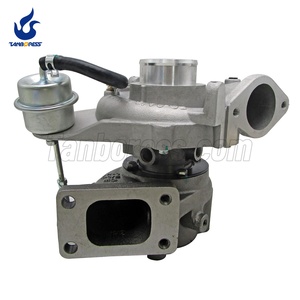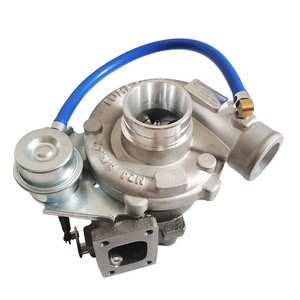(38 products available)











































































































































































Garrett turbochargers GT22 are a type of turbocharger that has gained popularity over the years. The GT22 is part of the GT series turbochargers, which are known for their advanced aerodynamics and reliability.
There are various types of turbochargers, including:
Single turbocharger
The Single Turbocharger is the most common type of turbocharger. It has a single turbine and compressor wheel that is connected to the engine's exhaust system. The turbine is spun by the exhaust gases, which in turn compresses the incoming air and forces it into the engine. Single turbochargers are popular because of their simplicity, low cost, and minimal lag. However, they may not provide sufficient power at high RPMs compared to other turbo types.
Twin turbocharger
Twin Turbochargers are another popular type of turbocharger. They use two turbines and compressor wheels, which are either installed in parallel or in a staggered arrangement. Parallel twin-turbochargers improve low-end and high-end power delivery. In contrast, staggered twin-turbochargers enhance gradual power delivery. Twin-turbochargers offer better power and efficiency across the engine's RPM range. Nevertheless, they are more complex and expensive than single turbochargers.
Variable geometry turbocharger (vgt)
Variable Geometry Turbochargers (VGTs) are designed to optimize the airflow through the turbine, regardless of the engine's speed. VGTs have adjustable vanes that change the turbine's geometry, improving boost response and efficiency across the entire RPM range. This technology eliminates turbo lag and provides a more linear power delivery. VGTs are mostly used in diesel engines, particularly in turbocharged diesel engines, where they improve low-end torque and emissions control.
Variable twin-scroll turbocharger (vts)
Variable Twin-scroll Turbochargers (VTSs) combine the benefits of twin-scroll technology with variable geometry. VTSs have two turbine and compressor sets, each with adjustable vanes. The variable geometry allows for better tuning of the boost pressure and response, while the twin-scroll design reduces turbo lag and improves overall efficiency. VTSs are suitable for high-performance engines that require precise boost control and quick throttle response.
Specification plays a critical role when selecting turbochargers for various applications. Here are the specifications for the Garrett GT22 turbochargers:
GT2219s Turbocharger:
Compressor section: 119 mm inducer diameter, 142 mm exducer diameter, 47.4 Compressor A/R, 5.2 Pressure ratio.
Turbine section: 41 mm turbine wheel diameter, 60 mm turbine wheel exducer diameter, 14.3 Turbine A/R.
Engine displacement: 1.0 L - 1.3 L
GT2256s Turbocharger:
Compressor section: 158 mm inducer diameter, 174 mm exducer diameter, 64.5 Compressor A/R, 6.7 Pressure ratio.
Turbine section: 50 mm turbine wheel diameter, 70 mm turbine wheel exducer diameter, 17.5 Turbine A/R.
Engine displacement: 1.4 L - 1.8 L
GT2260s Turbocharger:
Compressor section: 156 mm inducer diameter, 183 mm exducer diameter, 66.3 Compressor A/R, 5.8 Pressure ratio.
Turbine section: 60 mm turbine wheel diameter, 76 mm turbine wheel exducer diameter, 16.3 Turbine A/R.
Engine displacement: 1.6 L - 2.1 L
GT2280s Turbocharger:
Compressor section: 166 mm inducer diameter, 197 mm exducer diameter, 81.5 Compressor A/R, 6.2 Pressure ratio.
Turbine section: 61 mm turbine wheel diameter, 85 mm turbine wheel exducer diameter, 16.7 Turbine A/R.
Engine displacement: 1.8 L - 2.3 L
GTX2052R Turbocharger:
Compressor section: 51 mm inducer diameter, 70 mm exducer diameter, 60 Compressor A/R, 5.2 Pressure ratio.
Turbine section: 45 mm turbine wheel diameter, 64 mm turbine wheel exducer diameter, 14.8 Turbine A/R.
Engine displacement: 1.0 L - 1.6 L
GTX2062R Turbocharger:
Compressor section: 55 mm inducer diameter, 68 mm exducer diameter, 61.4 Compressor A/R, 5.9 Pressure ratio.
Turbine section: 47 mm turbine wheel diameter, 64 mm turbine wheel exducer diameter, 14.8 Turbine A/R.
Engine displacement: 1.0 L - 1.6 L
GTX2076R Turbocharger:
Compressor section: 59 mm inducer diameter, 76 mm exducer diameter, 65.4 Compressor A/R, 6.3 Pressure ratio.
Turbine section: 53 mm turbine wheel diameter, 76 mm turbine wheel exducer diameter, 16.7 Turbine A/R.
Engine displacement: 1.5 L - 2.5 L
Every turbocharger has its unique specifications. However, some general maintenance requirements are as follows.
1. Oil changes:
Regular oil changes ensure the turbocharger functions optimally. The oil lubricates the moving parts of the turbo to reduce wear and tear. It also helps transfer heat away from the components. While changing the oil, it is advisable to use the manufacturer's recommended oil.
2. Air filter replacement:
The air filter prevents debris and dirt from entering the turbo and engine. When the air filter is clogged, the airflow is restricted. This puts excess strain on the turbo to pull air, which could lead to turbo failure.
3. Use quality fuel:
Using quality fuel prevents the turbo from damage. Low-quality fuel can lead to knocking, which damages the engine and the turbo. The manufacturer's recommended fuel has additives that keep the engine and turbo healthy.
4. Warm-up and cool-down:
Proper warm-up and cool-down are essential for turbo maintenance. Before driving, let the car idle for a few minutes. This allows oil to circulate and lubricate the turbo. After driving, let the car idle for a few minutes before turning off the engine. This cools the turbo and prevents heat damage.
5. Regular inspections:
Regular inspections of the turbo are necessary to ensure it is in good condition. Check the turbo for any signs of damage or wear. Inspect the pipes and hoses for leaks. Look for any warning lights on the dashboard.
When sourcing Garrett turbochargers GT22 for business, consider these factors:
Application Suitability
Select turbochargers that match the intended use, whether for performance cars, heavy-duty trucks, or industrial machinery.
Engine Compatibility
The turbocharger must be compatible with the target engine's make, model, and type (gasoline or diesel) to ensure optimal performance.
Performance Specifications
Consider the turbine size, compressor maps, and boost pressure levels to match the desired performance metrics such as horsepower and torque.
Quality and Reliability
Garrett is known for its quality, but researching reviews and reliability data can help ensure the chosen GT22 turbochargers have a track record of durability.
Ease of Installation
Some turbochargers are easier to install than others. For aftermarket units, check if modifications are needed for quicker and cheaper installations.
Warranty and Support
Longer warranty periods and responsive aftermarket support can be crucial for business, so consider these factors when sourcing.
Price and Value
While it's important to garret turbochargers gt22 at a competitive price, prioritize value over cost. The turbocharger should provide a good ROI through performance gains, fuel efficiency, and reliability.
Upgradability and Future-Proofing
If the business plans to upgrade engines for more power, it's wise to source turbochargers that can support future performance targets.
Emissions Compliance
Ensure the turbocharger complies with local emissions standards, especially for vehicles operating in urban areas with strict regulations.
Reviews and Recommendations
Consult forums, industry reviews, and peers' recommendations to identify popular and trusted GT22 turbocharger models.
Replacing the turbo can be a DIY-friendly job for many car owners. The basic tools needed for the job include socket sets, wrenches, ratchet, extensions, and a torque wrench. It's important to go through the manufacturer's manual to ensure that the proper tools are available. Below are the steps for replacing the turbo:
Q1: What is the typical lifespan of Garrett GT22 turbochargers?
A1: There is no specific answer to this question because several factors affect the lifespan of GT22 turbos. However, with proper usage and maintenance, the turbochargers can last up to 150,000 miles or more. The mileage of the turbocharger will be affected by the driving style, maintenance, and oil quality.
Q2: How can people tell that a turbocharger is damaged?
A2: Turbochargers don't get damaged suddenly. The damage occurs gradually, and there are several signs that people can notice. Some of the signs include loss of acceleration power, excessive exhaust smoke, whining noises when accelerating, burning smell from the exhaust, and check engine light. If any of these signs are detected, it is important to inspect the turbo to avoid further damage.
Q3: Can turbochargers be upgraded?
A3: Yes, upgrading the turbo is possible. However, people should consult the experts before upgrading to ensure that the turbo is compatible with the engine.
Q4: What is the difference between turbochargers and superchargers?
A4: While turbochargers use exhaust from the engine to spin a turbine and force more air into the engine, superchargers are driven by the engine's crankshaft. As a result, superchargers don't improve fuel efficiency like turbochargers.